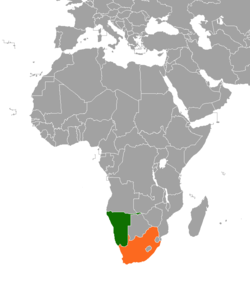Namibia–South Africa relations
 | |
Namibia |
South Africa |
|---|---|
Namibia–South Africa relations refers to the current and historical relationship between Namibia and South Africa. South Africa conquered the area now known as Namibia from Germany during World War I and occupied it until 1990, when it gained independence. During those 75 years, thousands of South Africans settled in Namibia and South Africa treated the area as an internal province rather than occupied foreign entity, imposing apartheid laws in Namibia as it did in South Africa.
Pre-Namibian independence (1915-1990)
South Africa conquered and occupied what was then German South-West Africa beginning in 1915 during World War I. From 1915, South-West Africa (as it was called) was administered by South African administrators and control of the area came from Pretoria. Many white South African settlers moved to the area and established farms on previously African-controlled pastures. From 1966 until the 1980s, the South West Africa People's Organization (SWAPO) fought a War of Independence against the South African Defence Force (SADF), which from 1974 onward included battles with Cuban troops as well as the People's Armed Forces for the Liberation of Angola (FAPLA). During this period, Namibia was administered essentially as a fifth province of South Africa, as it was integrated economically and militarily under the apartheid regime.
Post-Namibian independence (1990-)
Economy
Upon independence in 1990, Namibia's economy was still tied to South Africa's.[1] To this day, the economy of Namibia is still closely connected to South Africa through both institutional relationships (Southern African Customs Union, for example) and privately owned mining concessions.[2] The South African rand is still legal currency within Namibia, while the Namibian dollar is not so in South Africa and the currencies are traded on par locally. In 2010, trade between the two states totaled 436,689 South African Rand (approximately US $64 million), down from 927,917 rand in 2007.[3]
Walvis Bay
The issue of Walvis Bay, an important port over which South Africa retained control following independence, was returned to the government of Namibia on 1 March 1994, prior the election of Nelson Mandela as President of South Africa.[4]
References
- ^ In Namibia, South African Is Center of Attention, New York Times, 23 March 1990
- ^ Namibia - Economy
- ^ South African Trade by Country South African Department of Trade and Industry
- ^ Treaty between the Government of the Republic of South Africa and the Government of the Republic of Namibia with respect to Walvis Bay and the off-shore Islands, 28 February 1994
Further reading
- A New Small State with a Powerful Neighbour: Namibia/South Africa Relations since Independence by Graham Evans, The Journal of Modern African Studies, March 1993
External links
- SA, Namibia push corridor development SouthAfrica.info, 8 November 2010

